Pavilion of Prince Teng
The Pavilion of Prince Teng (traditional Chinese: 滕王閣; simplified Chinese: 滕王阁; pinyin: Téngwáng Gé) is a building in the North West of the city of Nanchang, in Jiangxi province, China, on the east bank of the Gan River and is one of the Three Great Towers of southern China. The other two are the Yueyang Tower and the Yellow Crane Pavilion. It has been destroyed and rebuilt many times over its history. The present building was rebuilt in 1989 on the original site. The rebuilding plan was devised by the architect Liang Sicheng, and now the Pavilion of Prince Teng is the landmark of Nanchang. There are nine floors in total. The main architectural structure is in Song dynasty wooden style, showing the magnificence of the Pavilion.
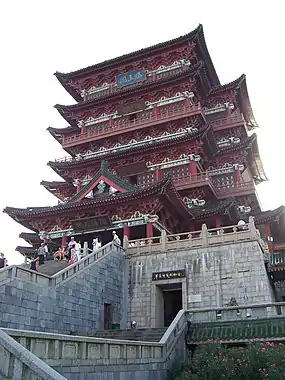
| Pavilion of Prince Teng | |||||||||||||||||
|---|---|---|---|---|---|---|---|---|---|---|---|---|---|---|---|---|---|
.svg.png.webp) "Pavilion of Prince Teng" in Simplified (top) and Traditional (bottom) Chinese characters | |||||||||||||||||
| Traditional Chinese | 滕王閣 | ||||||||||||||||
| Simplified Chinese | 滕王阁 | ||||||||||||||||
| |||||||||||||||||
History


The Pavilion of Prince Teng was first built in 653 AD, by Li Yuanying, the younger brother of Emperor Taizong of Tang and uncle of Emperor Gaozong of Tang. Li Yuanying was enfeoffed as Prince Teng in 639 and spent his early years in Suzhou. In 652 he was assigned the governorship of Nanchang where the pavilion served as his townhouse. The Pavilion of Prince Teng is the only existing royal architecture in southern China. Twenty years later, the building was rebuilt by the new governor. Upon its completion, a group of local intelligentsia gathered to compose prose and poetry about the building. The most famous of these is the Preface to the Pavilion of Prince Teng by Wang Bo. This piece made the Pavilion of Prince Teng a household name in China down to the present day.
The Pavilion was subsequently destroyed and rebuilt a total of 29 times over the next centuries.[1] The building itself changed shape and function many times. The penultimate construction was during the Tongzhi era of the Qing Dynasty. That building was destroyed in October 1926 during the chaotic Warlord Era.[2]
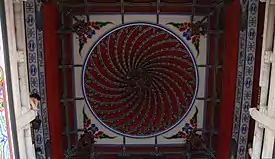
Recent
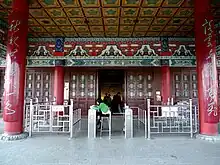
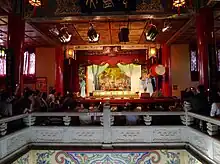
The present Pavilion of Prince Teng was built according to the design of architect Liang Sicheng, and was completed on 8 October 1989; now a landmark of Nanchang. The building is of reinforced concrete, but decorated in Song Dynasty style. It is 57.5 meters (189 ft) tall and has nine stories. The building has a total floor area of 13,000 square meters (140,000 sq ft).
The building sits atop a 12 meters (39 ft) tall concrete platform, which symbolizes the now-destroyed ancient city wall. A stainless steel tablet at the entrance is engraved with a calligraphy work of Mao Zedong: 「落霞与孤鹜齐飞,秋水共长天一色。」 ("Falling snow and lone goose flying together; a single hue, autumn water and the long stretch of sky."), a quotation from Preface to the Pavilion of Prince Teng.
The beautiful garden which is built in 1989 is the perfect ornament of the Pavilion. The building mainly serves tourism purposes. Apart from internal decoration, attractions include a theater that stages performances of period music, and displays of reconstructed ancient instruments. There are some restaurants and souvenir shops. The streets around the pavilion have been designed to conform with its style. This area has become the epicenter of Nanchang's antiques trade.
Influences
The Pavilion of Prince Teng achieved national fame through the Preface to the Pavilion of Prince Teng. As a result, it was endowed by later generations with almost legendary status as an example of magnificent architecture. When the Forbidden City was built, its corner towers were built to imitate the Pavilion of Prince Teng and the Yellow Crane Pavilion as depicted in Song Dynasty paintings. (Strangely, both pavilions are depicted identically in surviving paintings). These uniquely structured corner towers remain some of the most valued architectural treasures of the Forbidden City. The Pavilion of Prince Teng was regarded as the holy land in several dynasties in the history of China. In the meantime, it is the ancient library as well, storing a large number of precious scriptures and poems.
Construction timeline
According to Wang:[3]
| Year | Event |
|---|---|
| 653 | Constructed |
| 675 | Reconstructed |
| 790 | Reconstructed |
| 820 | Reconstructed |
| 848 | Reconstructed after being destroyed in a fire |
| 1108 | Reconstructed. Smaller structures added to the north and south of the main pavilion. The northern structure is named "Pulling Emerald-Green Pavilion" (Chinese: 挹翠亭; pinyin: Yì Cuì Tíng) and the southern structure is named "Pressing River Pavilion" (Chinese: 压江亭; pinyin: Yā Jiāng Tíng). |
| 1294 | Placed on top of the city walls after being damaged several times during wars. |
| 1336 | Reconstruction started in 1334 and completed in 1336 |
| 1436 | Reconstructed after sinking into the river. It is renamed "Greeting Kindness Hall" (Chinese: 迎恩堂; pinyin: Yíng Ēn Táng). |
| 1452 | Reconstructed after being destroyed in a fire. It is renamed "Number 1 Building in Xi Jiang" (Chinese: 西江第一楼; pinyin: Xī Jiāng Dí Yì Lóu). |
| 1468 | Reconstructed after it collapses. Its original name restored. |
| 1527 | Reconstructed after being destroyed earlier in the Chen Hao Uprising (Chinese: 宸濠之乱; pinyin: Chén Háo zhi Luàn). |
| 1599 | Reconstructed after being near collapse. |
| 1616 | Reconstructed after being destroyed in a fire. |
| 1634 | Reconstruction starts in 1633 and completes the following year. |
| 1648 | Destroyed when it catches fire while defending Ming generals torch surrounding area to open a clear perimeter against advancing Qing troops. |
| 1654 | Reconstructed |
| 1679 | Reconstructed after being destroyed in a fire. |
| 1682 | Reconstructed after being destroyed in a fire. |
| 1685 | Reconstructed after being destroyed in a fire. |
| 1702 | Reconstructed |
| 1706 | Reconstructed after being destroyed in a fire. |
| 1731 | Destroyed in a fire |
| 1736 | Reconstructed |
| 1743 | Reconstructed and again renamed "Number 1 Building in Xi Jiang". |
| 1788 | Reconstructed after it collapses. |
| 1805 | Reconstructed |
| 1812 | Reconstructed |
| 1847 | Reconstructed twice after multiple fires. |
| 1853 | Destroyed with much of Nanchang in a three-day fire during Tai Ping Rebellion attack. |
| 1873 | Reconstruction started in 1872 and completed the following year. |
| 1909 | Reconstructed after being destroyed in a fire. |
| 1926 | Destroyed by defenders when Nanchang is attacked by the Northern Expedition. |
| 1935 | An attempt to reconstruct is halted due to the Japanese invasion. |
| 1985 | Reconstructed |
| 1991 | The smaller buildings "Pulling Emerald-Green Pavilion" and "Pressing River Pavilion" are restored. |
Gallery
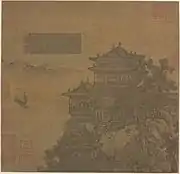 Prince Teng Pavilion by Xia Yong, Yuan dynasty
Prince Teng Pavilion by Xia Yong, Yuan dynasty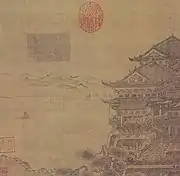 Prince Teng Pavilion by anonymous, Yuan dynasty
Prince Teng Pavilion by anonymous, Yuan dynasty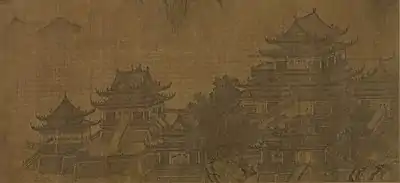 Prince Teng Pavilion by Xia Yong, Yuan dynasty
Prince Teng Pavilion by Xia Yong, Yuan dynasty Prince Teng Pavilion by anonymous, Yuan dynasty
Prince Teng Pavilion by anonymous, Yuan dynasty
Notes
- Wang: 1.
- Wang: 31.
- Wang: 236-246.
References
- Wang, Qiaolin (Chinese: 王巧林; pinyin: Wáng Qiǎolín) et al. 1996. Jiangnan Famous Site: The Pavilion of Prince Teng (simplified Chinese: 江南名胜 滕王阁; traditional Chinese: 江南名勝 滕王閣; pinyin: Jiāngnán Míngshèng Téngwáng Gé). Baihuazhou Literary Press (Chinese: 百花洲文艺出版社; pinyin: Báihuāzhōu Wényì Chūbǎnshè). 247 pages. ISBN 7-80579-797-8.